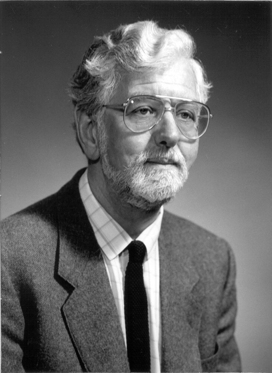Professor Alfred Jack Cole
Jack Cole
Jack Cole’s academic career started late due to the Second World War but was to span 40 years. Blown up by “friendly fire” in a wartime training exercise, Jack had to learn to write left-handed before entering tertiary education in his early twenties. A first class honours degree in Mathematics at University College, London was followed by the Mayer de Rothschild Scholarship to study for an MSc. Working with his mentor, Professor Harold Davenport, and aided by a London University Scholarship, Jack stayed on to complete a PhD in 1952 on the theory of numbers.
Born within the sound of Bow Bells, Jack proceeded to spend most of his academic career in Scotland and indeed eventually described himself as a “Scot by marriage”. Starting as a lecturer at the then Heriot-Watt College in Edinburgh (1952-6) he moved to Queen’s College, Dundee (1956-62).
Slowly but surely the potential of computer technology lured Jack into a career change and he returned south to the University of Leicester to become Director of the Computing Laboratory (1962-5). However, England did not hold him for long and in 1965 he returned to the University of St Andrews as Director of the Computing Laboratory and Reader in Computational Science.
For the next twenty years, Jack Cole devoted himself to establishing Computer Science at St Andrews. Promoted to a personal chair in 1969 and an established chair in 1976, Jack will be remembered for his dedication to the well being of the generations of undergraduate and postgraduate students that he taught and supervised. Dedicated to bringing the benefits of computer technology to all, one of Jack’s many innovations was pioneering the teaching of Information Technology to Arts students.
The combination of a background in mathematics and his fascination with computers provided Jack with his most successful research field. Working on space filling curves, which had earlier attracted the attention of such “greats” as Peano and Hilbert, Jack developed techniques that allowed them to be used in the compression of video data. In this he published widely culminating with the invention of Murray polygons. This research, while ahead of its time when Jack published, has now been taken up industrially by the BBC among others. In all Jack published three books and over fifty papers.
At a National level, Jack was President of the Inter-University Computer Colloquium in 1969 at a time when he and his sparring partner, the late Professor Sydney Michaelson, were the leading lights. Jack also served on numerous National committees including Health Service Bodies as a computing advisor.
Jack Cole’s outside interests included cats, home brewing, hill walking, folk music - who can forget his concertina playing - and the curious combination of golf and gardening hitherto thought to be incompatible in this part of the world. Most noteworthy of all was his loyal patronage of East Fife Football Club, sometimes known as EastFifeNil.
The Jack Cole Building was opened in 2005.
